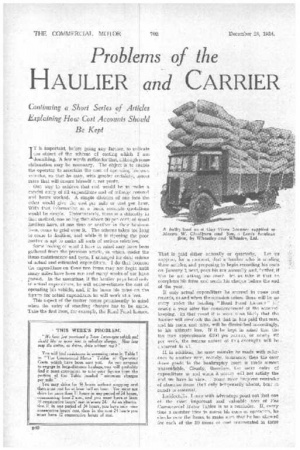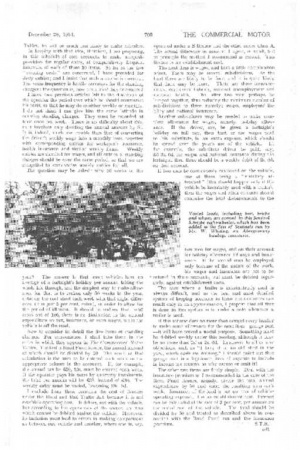Problems of the
Page 50

Page 51

If you've noticed an error in this article please click here to report it so we can fix it.
HAULIER and CARRIER
Continuing a Short Series of Articles Explaining How Cost Accounts Should Be Kept
IT is important, before going any farther, to indicate the object of the scheme of costing which I ant describing. 'A few words suffice for that, although some elaboration may be necessary. The object is to enable the operator to ascertain the cost of operating his own vehicles, so that he may, with greater certainty, assess rates that will ensure himself a net profit.
One way to achieve that end would be to make a careful entry of all expenditure and of mileage covered and hours worked. A simple division of one into the other would .give the cost per mile or cost per hour. With that information as a basis, accurate quotations would be simple. Unfortunately, there is a difficulty in that method, one so big that about 90 per cent, of small hauliers have, at one time or another in their business lives, come to grief over it. The scheme takes too long to come to fruition, and while it is ripening the poor haulier is apt to make all sorts of serious mistakes.
Some inkling of what I have in mind may have been gathered from the previous 'article, in which, under the items maintenance and tyres, I arranged for dual entries of actual and estimated expenditure. I do that because the expenditure on these two items may not begin until many miles have been run and 'many weeks of use have passed. In the meantime, if the haulier pays heed only to actual expenditure, he will under-estimate the cost of operating his vehicle, and, if he bases his rates on the figures for actual expenditure he will work at a loss.
This aspect of the matter comes prominently to mind when the entry of standing charges has to be made. Take the first item, for example, the Road Fund licence. That is paid either annually or quarterly. Let us
suppose, for a rnoment, that a haulier who is sending these articles, and proposing to begin recording his costs on January 1 next, pays his tax annually and, further, if this be not asking too much, let us take it that he completes his form and sends his cheque before the, end of the year. ,
If only actual expenditure be . entered in these cost records, as and when the occasion arises, there will be no entry under the heading "Road Fund Licence" for nearly a year after the commencement of the accountkeeping. In that event it is more than likely that the haulier will overlook the fact that he has paid that sum, and his costs, and rates, will be diminished accordingly; to his ultimate loss. If it be kept in mind that the tax may approximate £100 per annum, or nearly per week, the serious nature of this oversight will be • apparent to all.
If, in addition, the same mistake be made with reference to another item, namely, insurance, then the easy down grade to the bankruptcy court is made almost unavoidable. Clearly, therefore, the mere entry of expenditure as and when it occurs will not satisfy the end we have in view, Some more frequent reminder of absentee items (but only temporarily absent, bear in mind) is essential.
Incidentally, I may with advantage point out that one of the most important and valuable uses of The Commercial Mdtor Tables is as a reminder. If, every time a member fries to assess his costs of operation, he checks over the items, to make sure that he has allowed for each of the 10 items of cost enumerated in these
Tables, he will be much less likely to make mistakes.
In keeping with that idea, therefore, I am proposing, in this schedule of cost accounts, to make adequate provision for regular entry, at comparatively frequent intervals, of each of these 10 items. So far as the five "running costs" are concerned, I have provided for daily entries ; and I insist that such a course is essential. The same frequency is hardly necessary for the standing charges : the question is, how often must they he entered?
I have (see previous article) left to the discretion of the operator the period over which he should summarize his costS, so that he may do so.either weekly or monthly. I do not think I can give him the same latitude in entering standing charges. They must be recorded at least once per week. There is no difficulty about this, as it involves only dividing the annual amount by 50. It is, indeed, much less trouble than that of converting the driver's weekly wage into a monthly item, together with corresponding entries for workmen's insurance, health insurance and similar weekly items. Weekly entries are simplest for wages, and all entries of standing charges should be over the same period, so that we are compelled to standardize weekly entries for all.
The question may be asked: why 50 weeks in the year? The answer is that most vehicles have an average of a fortnight's holiday per annum, taking the whole life through, and the simplest way to make allowance for that is to reckon only 50 weeks to the year, debiting the cost sheet each week with that slight difference (it is just 5 per cent, extra), in order to allow for the period of idleness. It should be realized that, in 99 cases out of 100, there is no diminution in the annual expenditure on tax, insurance, or even wages, while the vehicle is off the road.
Now to consider in detail the five items of standing charges. For convenience, I shall take them in the order in which they appear in The Commercial Motor Tables. The first is Road Fund licence, the annual amount of which should be divided by 50. The result of that calculation is the sum to be entered each week in the appropriate column in the accounts. If, for example,, the annual tax be 230, 12s. must be entered each week. If the operator pays his taxes by quarterly instalments, the total per annum will be 233, instead of 230. The weekly entry must be varied, becoming 13s. 3d.
I exclude from these accounts the cost of licences under the Road and Rail Traffic Act, because it is not a-vehicle operating cost. It differs, not with the vehicle, but according to the operations of the owner, an item which cannot be debited against the vehicle. Moreover, its inclusion must lead to errors in making comparisons as between one vehicle and another, where one is, say,
operated under a B licence and the other under Class A.
The actual difference in amount, I agree, is small, but in principle the method I recommend is correct. This licence is an establishment cost.
The next item is wages, and here a little complication
arises. There may be several sub-divisions. At the least there are likely to be four, and it is quite likely that there may be more. Thei-e are three insuranc.e.
items : employers' liability, national unemployment and national health. The latter two may, perhaps, be lumped together, thus reducing the minimum number of sub-divisions to three, namely : wages, employers' lia bility and national insurance.
Another sub-column may be needed to make complete allowance for wages, namely, holiday allow ance. If the driver, say, be given a fortnight's holiday on full pay, then that, or the wages paid to his substitute, is an extra expense, which should be spread over the year's use of the vehicle. I.., for example, the substitute driver be paid, say, £6 3s. 6d. for wages and national insurance during the fortnight, then there should be a weekly debit of 2s. 6(1.
on that account.
If two men be continuously employed on the vehic:e,
one of them being a "statutory attendant " (this should happen only if th. vehicle be invariably used with a trailer), then the wages and other columns should comprise the total disbursements to the
two men for wages, and on their account for holiday allowance (if any) and insurances. If the second man be employed only because of the nature of the work, his wages and insurance are not to be s entered in these accounts, but must be debited. separ ately, against establishment costs.
The case where a trailer is intermittently used is always difficult, and as the best and most detailed system of keeping accounts in these circumstances can result only in an approximation, I propose that all that is done in this system is to make a note whenever a trailer is used.
If this scheme does no more than compel every haulier to make some allowance for the next item—garage rent —it will have served a useful purpose. Something must be debited weekly under this heading, although it may be no more than 2s: or 2s. Gd. In answer to all or any objections., such as "I keep it in an old shed in the yard, which costs me nothing," I should point out that garage rent is a legitimate item of expense to include in income-tax returns, so why excuse or omit it?
The other two items are fairly simple. Deal with the insurance premium as I recommended in the case of the Road Fund licence, namely, divide the total annual expenditure by 50 and enter the resulting sum each week. Insurance•of the load is not an item of vehicleoperating expense ; it is an establishment cost. Interest can be calculated at the rate of 3 per cent, per annum on the initial cost of The vehicle. The total should be divided by 50 and treated as described above in connection with the Road Fund tax and the insurance premium. " • S. T.R




















































































